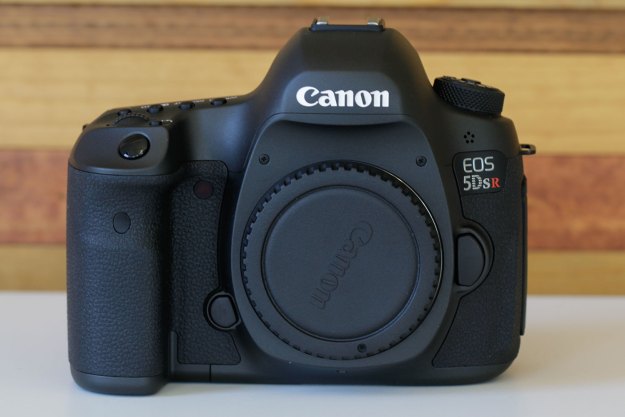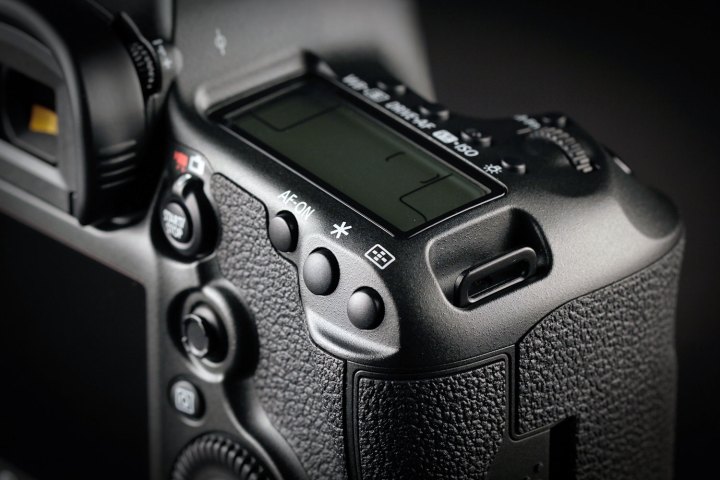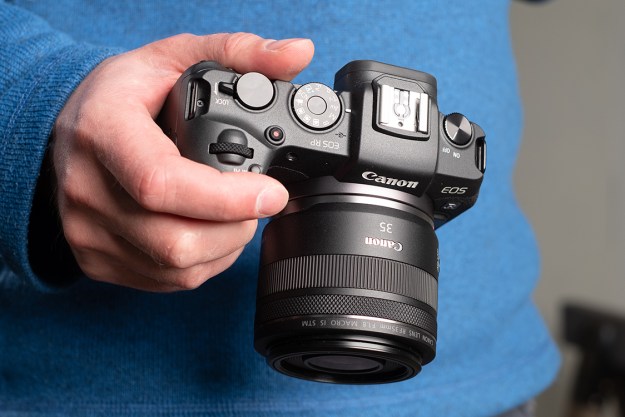
“For photography purists, Canon’s 5DS R DSLR delivers outstanding stills at a whopping 50.6 megapixels.”
- Beautiful 50.6MP stills
- Excellent optical viewfinder
- Good low-light performer
- Affordable alternative to medium-format
- Expensive for casual use
- Video only up to 30p
- Focusing issues in video recording
- No built-in wireless
The Canon EOS 5DS R and the companion EOS 5DS are the highest-megapixel cameras you can buy (to date) before entering medium-format territory. At $3,899 (body only), it’s clearly targeted to a small subset of enthusiasts, artists, working photographers, and other Canon-owning pros – the people who use their photos in other things besides social media. While it isn’t a camera for everyone (not just a price barrier, but in functionally as well), the world’s number-one camera company deserves accolades for engineering this full-frame shooter. For the ideal customer, the 5DS R delivers outstanding photo quality.
Features and design
On the outside, the Canon EOS 5DS R and EOS 5DS are identical, except the different logos on the front. Both are all-black interchangeable lens cameras with textured finishes. There’s nothing startling or unusual about them, but just realize they are big and bulky – measuring 6 x 4 x 3 inches and weighing 32.8 ounces without a lens.
The EOS 5DS R is the highest-megapixel camera you can buy without going to medium-format.
The only technical difference between the $3,699 5DS and 5DS R is there’s no optical low-pass (a.k.a., anti-aliasing) filter in the R model, which helps increase sharpness. Frankly, most people would need to look really hard to see the difference in the images they produce. So, you could apply this review to the 5DS (and save $200 if you don’t need the feature), a camera that delivered quality photos; we expected the same performance, if not better, from the 5DS R (click here to read our hands-on review of the 5DS).
On the front is the Canon EF mount, and only EF-series lenses are recommended (versus the EF-S cropped lenses, which aren’t compatible). This isn’t an issue as the company offers a large selecton of glass, as well as third-party options too. (For our review we used an f/1.8 50mm prime and an f/4 24-105mm IS USM standard zoom.) Also on the front are a remote sensor, self-timer lamp, lens release, and depth-of-field preview buttons, as well as a tiny mono microphone (optional stereo mic can be plugged into the mic jack on the side).
You’ll find the hot shoe on the top deck, with a locking mode dial and on/off switch on one side, and on the other side, buttons for White Balance/Metering, Drive/AF type, Exposure Compensation/ISO, and lamp (for illuminating the mono LCD that shows shooting parameters). Toward the top of the grip are a jog wheel, an AF-area selection/Multi-function key, and an angled shutter button. Like other high-end Canon DSLRs, you won’t find a built-in flash.
The two dominant features on the back are the large optical viewfinder with diopter control and 3.2-inch fixed-position LCD display (rated 1.04 million dots). The viewfinder offers 100-percent coverage with .71x magnification, and it’s excellent. The LCD, on the other hand, is adequate but not world class; studio photographers would attach laptops or monitors as their view screens anyway.
There are a lot of buttons on the back. To left of the LCD are Delete, Playback, Enlarge/Reduce, Rate, and Creative Photo/Two-Image Display (the latter functions are geared toward pros). Nearby are Menu and Info buttons; Live View Control for stills/video, as well as a center start/stop for recording; and AF-ON, AE Lock, and AF point selection. Given the camera has a 61-point AF system (41 cross-type), you can choose among any of them by using the joystick or jog wheel. We liked that the joystick is raised and easy to control. The nearby Q (Quick) key gives access to the available parameters, plus there’s a large control wheel with center Set button. Finally there’s a Multifunction Lock switch that prevents inadvertent camera adjustments.
On the right side is a compartment for two cards, CompactFlash and SD. The CF slot accepts Type-1/UDMA-rated media, and all SD cards can be used including SDXC. Although Canon doesn’t recommend the fastest cards available, we suggest you get one to speed the flow of 50.6MP files. The camera also supports USB 3.0 for faster file transfers.
The bottom of the 5DS R has the tripod mount and battery compartment. The power pack is rated 700 shots per CIPA but drops to around 200 when using Live View exclusively
What’s included
Canon supplies the body, strap, removable eyecup, battery, and plug-in charger. You also get a printed Basic Instruction Manual and a CD with the entire manual. The EOS Digital Solution Disk has a variety of programs for handling images and RAW files. The camera does have a built-in RAW file converter for dealing with that task in the field. The 5DS R does not have built-in Wi-Fi or NFC. Why Canon omitted this seemingly ubiquitous feature is a mystery when it’s available on the older full-frame EOS 6D. We guess buyers of this camera aren’t interested in sharing their images on social media but if they are, Canon has a Wi-Fi adapter for $850.
Warranty
Canon offers a typical one-year warranty for parts and labor. Canon also offers an extended warranty plan, called CarePak Plus ($110-$150), which covers accidental damage and offers live support. Since the camera is very expensive, you may want to consider this option.
Specs, performance, and use
The EOS 5DS R has a 50.6MP full-frame CMOS sensor powered by two Digic 6 processors. This lets the camera capture 8,688 x 5,792-pixel files at a very respectable 5 frames per second, just like the Sony A7R Mark II. The 50.6MP chip is the most pixels you can get in a DSLR or mirrorless camera, as of this writing.
Having used both the 5DS and 5DS R for a few months, we thought we would be familiar with using them. But we only just scratched the surface of their capabilities, and it will require months of experimenting to become familiar with all the menu options, such as the Fine Detail mode in the Picture Styles menu that gives access to Sharpness sub-settings. We’re sure studio photographers will have a ball with this, but since we’re not studio shutterbugs, all of our shots were handheld.
Unlike Canon’s ultra-high-end pro DSLR, such as the $5,300 EOS-1D X, the 5DS R has a Smart Auto. Normally you would find this on entry- and mid-level DSLRs, so it’s surprising that Canon would put it on here. With that said, we have seen experienced photographers use this mode in situations where they just want to quickly capture a fleeting moment. There are also three custom options available on the dial, as well as a Bulb mode (used for long exposure).
The 5DS R has a native ISO range of 100-6,400 but you can hit 50 and 12,800 via expansion settings. The camera is an excellent low-light performer and our sample subject held up very well to ISO 3,200, and even 12,800 was usable. The built-in optical image stabilization of the zoom did a fine job keeping things steady and sharp.
- 3. Shot on Canon EOS R.
When we reviewed images on a 27-inch monitor in full and enlarged sizes, we were impressed with the results. Color accuracy was spot on, and we liked the sharpness from the f/4 zoom. Keep in mind that we were also hand-holding the camera for most of our shots. The lenses we used aren’t even Canon’s top or most expensive, so imagine the quality from even better lenses. If you’re a working photographer who has an arsenal of excellent Canon lenses, you should check out the 5DS R or the 5DS if you haven’t already.
What’s not so fine is the 5DS R’s movie mode. The one real knock is the very limited and somewhat archaic 1920 x 1080/30p maximum resolution. We’re well aware Canon explicitly stated the 5DS R was designed to maximize still quality, and 30p in itself isn’t terrible (until we all adopt 4K screens, that is). However, in the camera industry, 30p video is well behind DSLR and mirrorless competitors. We shot a number of clips and although the color was all right, the camera had trouble focusing (this can be seen in the clip of rain pouring off a rooftop). Is this the end of the world? Not for photographers, but it’s something to keep in mind if you shoot video as well.
Where to Buy: Amazon Adorama Best Buy Canon
Conclusion
The DT Accessory Pack
Canon Battery Pack LP-E6N ($63.63)
The camera sucks up battery power when in Live View mode. If you need this function, pack a spare.
Canon Interface Cable IFC-150U II ($25)
This USB 3.0 cable lets you tether the camera to a computer for fast transfers.
Canon DR-E6 DC Coupler ($44.50)
If you are working indoors, you can provide uninterrupted power to the camera with this accessory.
In terms of camera tech, Canon is to be commended for creating a 50.6MP full-frame DSLR, so it earns our Editor’s Choice. While the near-$4,000 price tag puts it out of reach for consumers, it’s relatively affordable for the type of user this camera is geared toward. To get more megapixels, you’d have to go to medium-format, which are expensive and not as portable. We loved using this camera, and for a photo purist like this reviewer, the pictures have that classic Canon “feel” we’ve always appreciated over the years. This big baby is a winner, as long as filmmaking isn’t at the top of your wish list.
However, like medium-format cameras, the 5DS R requires a commitment. It’s big and bulky, and you’ll need to invest in top-shelf glass if you don’t own any. The 5DS R and 5DS are no brainers for Canon pros who are looking for their next camera body, who need that resolution. For others, there are a lot of versatile options, like Sony’s A7R II (read our comparison, which has the highest-megapixel sensor in a full-frame mirrorless camera, but is far more flexible than the 5DS R) or some future follow-up to the 5D Mark III.
Highs
- Beautiful 50.6MP stills
- Excellent optical viewfinder
- Good low-light performer
- Affordable alternative to medium-format
Lows
- Expensive for casual use
- Video only up to 30p
- Focusing issues in video recording
- No built-in wireless
Editors' Recommendations
- Lens teardown reveals how Canon made an affordable super-telephoto
- Should you buy the Canon EOS R5 or EOS R6? The new mirrorless options compared
- Canon EOS R5 is everything the R isn’t, thanks to stabilization, 8K, dual slots
- Nikon Z 50 vs. Canon EOS M6 Mark II: Nikon’s newest takes on Canon’s champ
- The Canon EOS R has a new big brother. Meet the made-for-stargazing Canon EOS Ra













